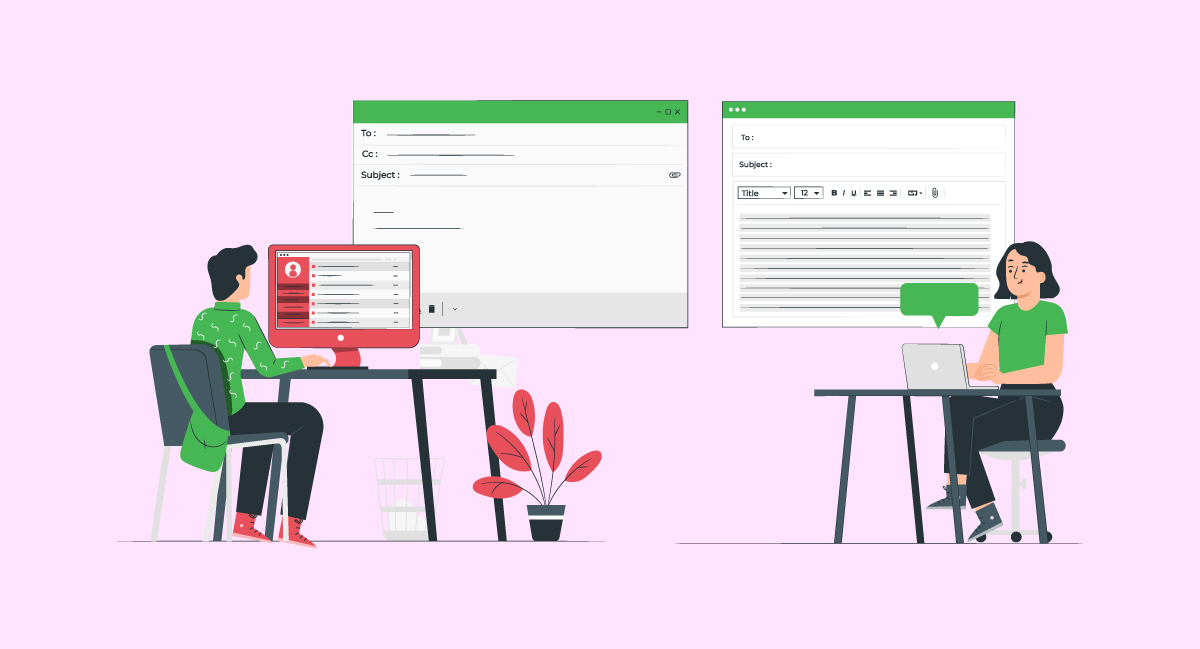Email has become the go-to mode of communication in the professional realm. Whether it’s reaching out to colleagues, clients, or potential business partners, the way we craft our emails plays a critical role in conveying our message effectively. However, many individuals fall into common pitfalls that can hinder the impact and professionalism of their emails.
With over 333.2 billion emails sent and received every day, it becomes essential to stand out from the rest.
If you are wondering how to write a good email, you have come to the right place. In this blog, we will explore some of the most common email writing mistakes and provide professional email tips on how to fix them. This article also guides the users with a proper way to write an email that makes an impact.
Expert Advice
Professional email writing is known to drive higher growth and increase conversion rates. Craft an email that hits the right points, is simple to grasp, and provides value. Make sure to follow these professional email writing tips to ensure better open rates and increase bottom-line results
By mastering the art of writing effective emails, you can enhance your communication skills, establish stronger professional connections, and achieve your desired outcomes with greater efficiency. Let’s dive in!
What Are the Factors to Consider Before Writing a Professional Email?
Before you understand how to write effective emails, you must have better clarity on your purpose and what you want to achieve from it. So, below are the main factors you need to consider.

1. Purpose and Goal
Clearly define the purpose of your email and what you hope to achieve. Are you seeking information, making a request, providing updates, expressing gratitude, or initiating a business proposal? Understanding your objective will help you structure your email effectively and convey your message with clarity.
2. Audience Analysis
Consider your audience carefully. Identify who will be receiving your email and tailor your message accordingly. Consider their role, level of familiarity with the topic, and any cultural or organizational norms that may influence your communication style. Understanding your audience will allow you to strike the right tone and choose the appropriate language and level of formality.
3. Email Etiquette
Familiarize yourself with general email etiquette to ensure your message is received positively. Use a professional email signature with your full name, job title, and contact information.
Avoid using all capital letters (which can be interpreted as shouting) and excessive exclamation marks, as they may appear unprofessional or overly enthusiastic. Respond to emails in a timely manner to show respect for the recipient’s time.
4. Politeness and Respect
It is important to maintain a polite and respectful tone throughout your email. Use appropriate language, avoid offensive or derogatory remarks, and be mindful of cultural sensitivities. Address the recipient by their proper title and name, and avoid using overly familiar or informal language unless your relationship with the recipient allows for it.
How To Write An Effective Email? 12 Pro Tips
Writing an effective email requires careful attention to both content and tone. Here are some professional email writing tips to help you compose an impactful email:

1. Clear and Concise Subject Line
Your subject line should accurately convey the purpose of your email in a few words. A clear subject line helps the recipient understand the importance and relevance of your message, increasing the likelihood of it being opened and prioritized.
Moreover, you can also personalize the subject line based on different target audience.
2. Use a Professional Greeting
Begin your email with a polite and appropriate salutation. Address the recipient by their name if you know it, such as “Dear John,” or “Hello Sarah.” If you’re unsure about the person’s name or title, you can use a generic greeting like “Dear Sir/Madam.”A professional and appropriate greeting sets the tone for your email.
3. Personalize your Email
Whenever possible, personalize your email by addressing the recipient by their name and using specific details relevant to your relationship or previous conversations. This personal touch shows that you value the recipient and helps to build a stronger connection. In fact, 80% of consumers are more likely to make a purchase from a company that provides personalized experiences.
4. Get to the Point Quickly
Busy professionals appreciate emails that reach the main point without an unnecessary preamble. State the purpose of your email concisely in the first few sentences. Avoid lengthy introductions or unrelated information. By being direct, you respect the recipient’s time and increase the chances of your message being read and understood.
5. Use a Professional Tone
Maintain a polite and professional tone throughout your email. Avoid using slang, jargon, or overly informal language. Write in complete sentences, and use proper grammar and punctuation throughout the entire message in your email. A professional tone demonstrates your professionalism and helps build a positive impression.
6. Provide Context and Necessary Information
If your email requires the recipient to take action or make a decision, provide any relevant background information or supporting documents. Be specific and include all necessary details, such as dates, times, and locations. This ensures the recipient has all the information they need to understand and respond to your email effectively.
7. Use Short Paragraphs and Bullet Points
Breaking your email into short paragraphs improves readability. Each paragraph should focus on a single idea or topic. Use bullet points or numbered lists to highlight important points or action items. This formatting makes scanning and understanding your message easier for the recipient.
8. Consider Email Formatting on Different Devices
Remember that recipients may be reading your email on different devices with varying screen sizes. Use a font size and formatting that are easy to read on desktop and mobile devices. Avoid overly complex or large attachments that may cause difficulty accessing or viewing the content.
9. Use a Polite Tone
If you’re asking for a favor or assistance in your email, express gratitude and appreciation for the recipient’s time and help. Show respect for their expertise or willingness to assist you. A polite and grateful tone increases the chances of receiving a positive response and fosters positive professional relationships.
10. Proofread Before Sending
Before hitting the send button, take a moment to proofread your email. Check for spelling or grammar errors, and ensure your message is clear and concise. Reading your email aloud can help you identify awkward phrasing or unclear sentences. Proofreading ensures that your email appears professional and polished.
11. Follow up When Necessary
If you don’t receive a response within a reasonable timeframe, consider sending a polite follow-up email. Keep the follow-up concise and friendly, reminding the recipient of your previous message and politely requesting a response. Following up demonstrates your commitment and professionalism while ensuring that your email doesn’t get lost in a busy inbox.
12. End with a Clear Call to Action or Next Steps
Conclude your email with a clear call to action, specifying what you expect from the recipient or what they should do next. This helps avoid confusion and ensures that your email serves its intended purpose. If necessary, include any deadlines or relevant dates to provide a sense of urgency or timeframe.
In addition to the above tips, you can also leverage email writing tools to automate and personalize your campaigns. This can help reduce manual efforts and improve productivity.
Common Email Writing Mistakes And How To Fix Them
To appear professional and connect better with your intended audience, you need to target them with a to-the-point email, a descriptive subject line, and the right tone. Moreover, it’s crucial to be aware of common email writing mistakes to avoid sending poorly written emails to your business contacts.

1. Lack of Clear Subject Lines
One common mistake is not providing a clear and specific subject line for your email. A vague or generic subject line can make it difficult for the recipient to understand the purpose of your email and prioritize it appropriately.
Solution
To fix this, ensure that your subject line clearly summarizes the content or purpose of your email. For example, instead of writing “Meeting,” you can write “Request for Meeting on Project XYZ – Urgent.”
2. Rambling or Lengthy Emails
Sending emails that are too long or filled with unnecessary details can overwhelm the recipient and make it difficult for them to extract the key information. This can hamper your conversion rate as well, so it’s essential to avoid this mistake.
Solution
To avoid this mistake, be concise and get straight to the point when you begin writing the email. Focus on the essential details and organize your thoughts in a logical manner. Use bullet points or numbered lists to break down complex information into easily digestible chunks. Moreover, for a better response rate, you must send follow-up email messages to your audience.
3. Poor Grammar and Spelling Mistakes
Emails with grammar and spelling errors can undermine your professionalism and credibility. Finding petty errors or typos can also negatively impact your brand, which can result in losing out on important clients.
Solution
Always proofread your email before sending it to avoid typos or grammatical mistakes. Consider using spelling and grammar check tools or asking a colleague to review your email if you’re unsure. Ensuring your email is error-free demonstrates your attention to detail and enhances your professional image.
4. Lack of Clarity and Specificity
Sending emails that are vague or lacking in clarity can lead to misunderstandings and confusion. If your email doesn’t mention the main objective of why you’re sending the email, there won’t be any benefit from it.
Solution
To address this, be specific in your communication and send it from your professional email address. Clearly state your purpose, expectations, and relevant deadlines or action items. Provide all the necessary information the recipient needs to understand and respond to your email effectively. Avoid using ambiguous language, and always double-check that your message is clear and unambiguous.
5. Inappropriate Tone or Lack of Professionalism
Tone matters in email communication, and using an inappropriate tone can lead to strained relationships or misunderstandings. In fact, many customers have mentioned that they avoid doing business with companies that appear unprofessional.
Solution
Always strive for a professional and polite tone, even when addressing a challenging or sensitive issue. Avoid overly casual or informal language, and be mindful of cultural differences. Read your email from the recipient’s perspective to gauge if the tone is appropriate and adjust as necessary. Moreover, you can also add an email signature that mentions your company website in your future conversation to appear more professional.
By being aware of these common email writing mistakes and implementing the suggested fixes, you can improve your email communications’ clarity, effectiveness, and professionalism. You can also use email management software to keep track of your email campaigns and measure their performance.
Wrapping up
In conclusion, effective email writing is a crucial skill in today’s professional world. By avoiding common mistakes, you can significantly enhance the impact of your email messages. Following these email writing tips can build stronger professional relationships, convey your message more effectively, and ultimately achieve your desired outcomes through email communication.
Remember, practice and attention to detail will refine your email writing skills, making you a more effective and proficient communicator. So, start writing and impress your prospects with the best email message!
Frequently Asked Questions

Supriya is a highly skilled content writer with over 8 years of experience in the SaaS domain. She believes in curating engaging, informative, and SEO-friendly content to simplify highly technical concepts. With an expansive portfolio of long-format blogs, newsletters, whitepapers, and case studies, Supriya is dedicated to staying in touch with emerging SaaS trends to produce relevant and reliable content.
Need Any Technology Assistance? Call Pursho @ 0731-6725516





